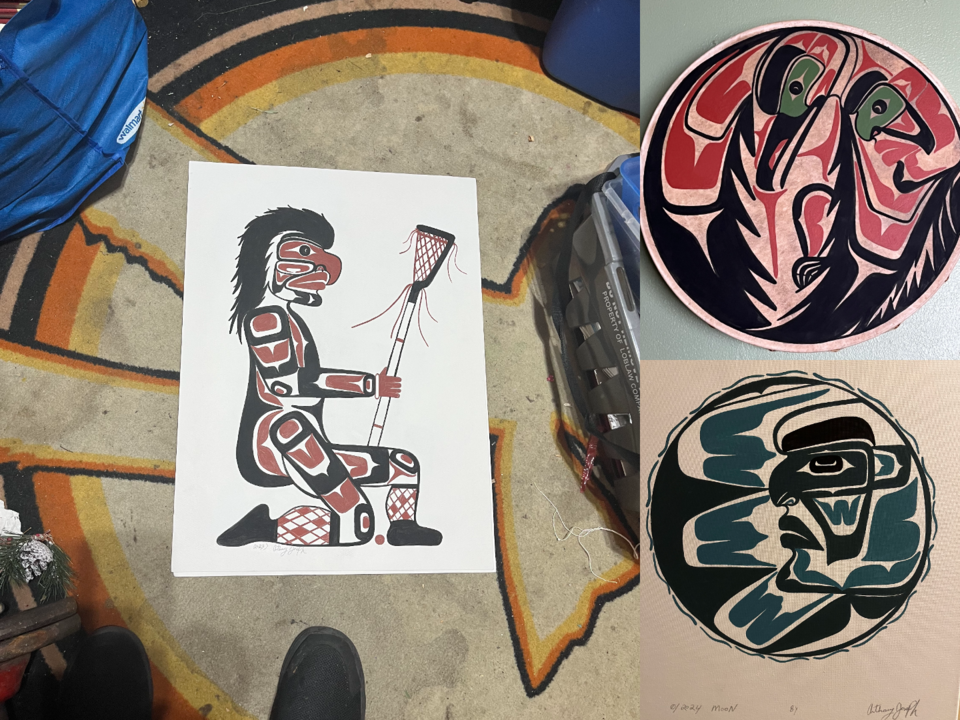Sḵwx̱wú7mesh Úxwumixw (Squamish Nation) artist SiytaK’elten aka Anthony Gabriel Joseph is set to lead a drum-making workshop at Capilano University in Squamish.
For over 20 years Joseph has been creating and teaching the art of drum making and on Oct. 15 and Nov. 12 will provide participants the opportunity to make their own traditional drums while learning about their significance.
A family tradition of artistry and drum-making
Joseph, who grew up surrounded by the artistic traditions of his family, says that the cultural environment of the Nation has heavily influenced his approach to his work.
"It’s more about the people around me. In our nation, we have over 2,000 artists now," Joseph told The Squamish Chief.
He credits his father for inspiring his journey into the arts and the strong bond that was forged through learning from him.
“It made us really close. Like any parent, you love your parents, and he was an inspiration to all of us doing our artwork. We looked up to him,” Joseph said.
For eight years, Joseph shared his artistry through teaching workshops with Vancouver Child and Family Services.
He believes his experience teaching drum-making courses for the Yúustway– Squamish Nation Health and Wellness department was how he got his name “out there”.
He continues to pass on his knowledge through workshops, art shows, and projects.
Cultural significance of drums in Coast Salish traditions
According to Indigenous Tourism BC, “drums can be used at the beginning of an important meeting to pray for good work or at the end of an event to pray for safe travels home for attendants.”
For Joseph, he believes that drum-making has deep cultural importance in the Coast Salish community.
“It’s a tradition for us. We use the drums in our longhouse,” he said.
Drums can also be used for spiritual work including ceremonial singing and dancing.
“Lots of my brothers are spiritual dancers, and they use drums when they sing and do their spiritual work,” Joseph said.
As for how he got into the art of drum making, Joseph credits his sister-in-law, Amelia Joseph.
“She taught me when I was younger, and I kept going to Vancouver, buying kits, making drums, and selling them. Now, I have lots in galleries, and I send them all over the world,” he said.
When asked about the personal meaning drums hold for him, Joseph spoke about the importance of maintaining a clear mind while creating them.
“Our grandmother always told us to put aside all negative thoughts when making drums. Many people pray with drums, so it’s important to approach it with a clear mind,” he said.
Drum-making process: Tradition meets craftsmanship
Participants in Joseph’s workshop will learn about the traditional process of creating drums, including the use of deer hide.
“When you get the hide, you have to soak it, then string it. Older people have their own ways, but I use the traditional method,” Joseph said.
He cautioned against the use of synthetic materials, which can cause the drum to break over time. “With deer hide, once it dries, it stays stable and doesn’t tighten up,” he said.
While he still creates drums, he has expanded into other mediums, including original paintings and prints.
Joseph has also created a welcome figure for the North Vancouver School District.“I’ve started doing more panels and prints, and I’ve worked on some big projects,” he said.
Advice for future Indigenous artists
For younger Indigenous artists looking to follow in his footsteps, Joseph’s advice is to “cherish what they do and stay in school”.
“It’s not really a job you can always rely on; it’s more like a hobby at first. But if you keep at it, like I have, you can make a good living from it,” he said.
The drum-making workshop at Capilano University is part of the university’s Squamish Family Learning Program, which also includes family literacy circles and board game gatherings to encourage community engagement.
Bhagyashree Chatterjee is The Squamish Chief’s Indigenous affairs reporter. This reporting beat is made possible by the Local Journalism Initiative.




